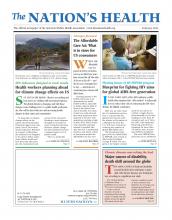Sea levels are rising. Glaciers are melting and heat waves are striking with increasing frequency. The global climate is changing, and with those changes come challenges for U.S. public health professionals, who will be faced with new and increasing health dangers in their states and communities.
To keep tabs on climate change effects on the nation, the Environmental Protection Agency has compiled a list of 26 environmental indicators. Released as a report in December, the indicators are designed to be used to better understand climate trends and how they may affect people, the environment and society. From increased flooding to more frequent droughts to increases in cases of tropical infectious diseases, climate change has been predicted to have a marked impact on U.S. public health.

Floodwaters cover a highway in Hopland, Calif., in December. New indicators are helping track effects of U.S. climate change.
Photo by George Rose, courtesy Getty Images
“This is a terrifically important report,” said Kim Knowlton, DrPH, senior scientist in the health program at the Natural Resources Defense Council. “It’s hugely important for us to determine indicators, which are simpler measures of complex changes in the global climate.”
The report comes at a time when climate change is at the forefront of the country’s consciousness. On Jan. 8, the National Oceanic and Atmospheric Adminstration announced that 2012 was the hottest year on record for the continental United States. Along the East Coast, many communities are still cleaning up from Hurricane Sandy, which struck with nearly unprecedented ferocity in an area that rarely sees such storms.
The report’s 26 indicators contain data that can be used to assess trends over time, support science-based decisionmaking and evaluate existing and future climate-related policies and programs. Indicators include U.S. greenhouse gas emissions, high and low temperatures, drought, tropical cyclone activity, snowfall, length of growing season and heat-related deaths.
The report adds three new indicators since the first edition in 2010: snowfall, streamflow and ragweed pollen season, and expands the Arctic sea ice, snow cover and drought indicators. The 2010 heat wave indicator was converted and is now called high and low temperatures.
The ragweed indicator is already yielding important information, said Knowlton, an APHA member. About 26 percent of all Americans are sensitive to ragweed, and an allergy can be especially dangerous in people who also suffer from asthma, particularly children.
Climate change can affect ragweed in several ways. Warmer spring temperatures can cause plants to start producing pollen earlier, according to the report, and warmer temperatures and more carbon dioxide can cause plants to produce more pollen. Data shows that the ragweed season in the northern Midwest increased in length by about two weeks between 1995 and 2011.
“These are very provocative dots on the map,” Knowlton said. “But what does this mean in terms of public health? It means more emergency room visits for allergies. If seasons become longer, the health effects may also be expanding.”
The indicators report also tracks shifts in weather patterns and conditions. For example, the report found that the depth of snow on the ground in early spring decreased at most measurement sites — some by more than 75 percent — between 1950 and 2000. But some locations in the western U.S. saw an increase.
In addition to the known health effects that may result from changing climates — including pollen allergies and the potential for greater West Nile virus infections if summers are wetter — there is also concern about the unknown.
“As the climate changes, we may see new hotspots for bacteria and viruses,” said Doug Sisterson, MS, a meteorologist who works on climate change issues at the Argonne National Laboratory outside Chicago.
Sisterson noted the wide range of scientists who worked on the indicators report and said collaboration among physicians, meteorologists, biologists entomologists and others will prove vital as climate change research moves ahead.
“What happens when climate changes is that birds and bugs, for example, can get swept up in the air flow and find their way to places where they weren’t before,” he told The Nation’s Health. “Doctors might not know that, but meteorologists do.”
Extreme weather events may be one of the topics with the most potential to touch the public health community most immediately, in part because there are so many of them and they affect so many people.
In a Union of Concerned Scientists study discussed during a scientific session at APHA’s 140th Annual Meeting last year, researchers looked at five Midwestern cities and found a statistically significant increase in the number of heat waves in those cities.
An increase in the number of heat waves is important to public health because local health departments are often tasked with keeping communities safe during such events, said Elizabeth Martin Perera, MPH, an APHA member and co-author of the heat wave study.
“Extreme heat is keeping temperatures high, even at night, which is a classic sign of climate change,” said Perera, the senior Washington representative with the Sierra Club.
The issue of preparedness looms large after hurricanes Katrina and Sandy, and with drought fueling forest fires and heat waves killing thousands, Knowlton said public health professionals are already serving on the front lines of the climate change battle. One tool that is being used is the Centers for Disease Control and Prevention’s National Environmental Health Tracking Network, which is gathering data on climate change and a range of other enviromental issues.
“There is terrific work in this regard happening in a number of states,” Knowlton said. “That kind of work really allows us to ask the important questions about what affects heat, drought, wildfires and things being fueled by climate change are having on the nation’s health.”
EPA’s “Climate Change Indicators in the United States,” report is online at www.epa.gov/climatechange. For more on the National Environmental Health Tracking Network, visit http://ephtracking.cdc.gov.
- Copyright The Nation’s Health, American Public Health Association












